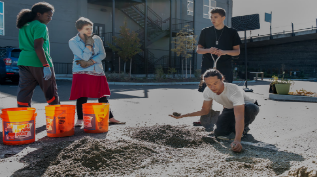Impact Investing: The Russell Family Foundation’s Journey From a Little to a Lot

Editor’s note: This column originally appeared on the Inside Philanthropy website and is shared here with permission of the authors.
The Russell Family Foundation (TRFF) practices impact investing as a long game built on experiential learning, resilient risk-taking and the primacy of relationships. Contrary to the playbook of traditional investing, where the dominant values are expressed as competition, proprietary and individual benefit, TRFF has chosen to flip the rules in its impact investing to aim toward collaboration (not competition), transparency (not opaqueness), and the common good (not private gain). Philanthropic foundations by definition and nature are purpose-driven enterprises, and the world we live in increasingly calls us to take a leap and ignite our portfolios to include mission-minded investments.
As foundations, we are meant to be catalytic, to lead by example, play well with others, and learn from instructive failures along the way. That’s true for our community grantmaking and civic engagement, as well as our impact investing strategies. Charting this territory to demonstrate impact, while maximizing mission and pursuing responsible returns, holds great power to demonstrate to others—regardless of sector—promising practices and lessons learned to ultimately galvanize a world that is more fair, just and equitable for all.
At TRFF, where I’ve served as CEO for nearly 20 years, I can tell you it has been a long journey to get to where we are today. For years, we’ve been practicing by different rules, changing our mental models and finding willing investment partners, as well as learning from our mistakes while charting a way forward from a little impact investing to a lot. As recently as 2013, our portfolio has grown from 7 percent mission aligned to nearly 75 percent impact invested in 2018—that translates to a little over $100 million of aligned investments of a portfolio totaling $140 million. Meanwhile, our returns over a five-year period are beating the blended benchmarks by nearly 3 percent.
Our journey is detailed in a new case study explaining our experiential learning—how we’ve reframed our policies and processes; how we’ve created a stronger internal infrastructure and made changes along the way. We hope the story we share serves as a resource to others hungry to flip their playbooks in the long game of impact investing.
We’re still learning and always will be, but to help others go from a little to a lot in impact investing, I offer the following advice.

Rethink your investment policy statement to be more explicit; review it regularly.
Updating your investment policy statement (IPS) may seem like the most basic concept, yet it serves as the north star for all actions and decision-making. By reviewing your IPS to be more explicit, including policies, clear objectives for growth and daily operations, an organization can ensure there is a shared understanding among staff, board members, investment advisors and other stakeholders.
The exercise of regularly reviewing your IPS allows for continued improvement and agility in making impact. It also allows for stakeholder voices to be heard and for change to happen more frequently.
As your organization gets comfortable with impact investing, perhaps by making small changes to start, your IPS can evolve and grow. This might mean making room for more “catalytic” investments, a strategy that may once have been out of the realm of possibilities.

Establish a new kind of investment committee.
In 2006, we financed a complex community project through a program-related investment (PRI) that ended up failing, and which we wrote off as a grant. It was this $500,000 total loss that had us reflect on our decision-making processes. We needed a more diligent and comprehensive internal system that brought together a better mix of informed decision-makers. This ultimately meant joining together program and finance teams.
By combining these talents, an organization can weigh financial and analytical skills with the impact and program oversight needed to be successful. This isn’t a new concept, but organizations need to ensure they leverage the committee to its greatest potential. This means training program staff on financial concepts and educating investment advisors on how social programming works to impact the community. It also means meeting regularly to review new impact investing opportunities and share key insights from current or previous investments.
A governing model was also critical to our success. Instead of just meeting to talk about portfolio and then leaving until our next quarterly meeting, we created an ongoing structure in which investing advisors and program staff conduct joint due diligence on prospective impact investments and collaboratively make recommendations. This helps ensure sound decision-making, while strengthening the collective team’s ability to work together on making smarter decisions.
Make incremental changes.
It took TRFF years to get real traction with its impact investments, but the greatest milestone was first divesting. “Divest to invest” is an approach that will be unique to all. It might mean divesting from the stock market or specific industries that do not support your mission, but the common denominator is freeing up funds to put toward your mission.
You might consider a pilot project to test the waters and help your stakeholder team become more comfortable with the idea that a mission-focused investment can, indeed, yield great financial returns. Use it as a case study to learn from and guide your portfolio. This was a useful exercise at TRFF as it helped break up our routines, habits and assumptions about business while narrowing our focus on impact integration across our activities.
I am a firm believer in the beginner’s mind, to learn by doing. When we have an open mind, the possibilities are endless. Wherever you are in the journey, I encourage you to overcome any resistance or misconceptions about mission-driven investing and to take a chance on making a greater impact.
For more information, read the complete report on the Russell Family Foundation’s impact investing journey.
